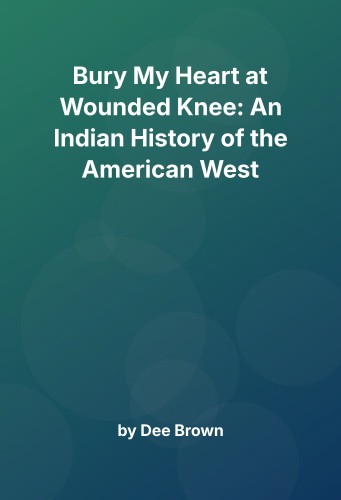Introduction
Dee Brown’s “Bury My Heart at Wounded Knee: An Indian History of the American West” is an evocative recounting of the systematic displacement and destruction of Native American tribes during the westward expansion of the United States in the late 19th century. Published in 1970, this seminal work provides a powerful narrative that highlights the perspectives of various Native American leaders, culminating in the tragic massacre at Wounded Knee Creek in 1890.
Core Frameworks and Concepts
In understanding the historical narrative presented by Dee Brown, it is essential to grasp the frameworks that underpin the systemic injustices faced by Native American tribes. This section will explore these frameworks, drawing comparisons with other historical analyses to provide a comprehensive understanding.
Colonial Expansion and Systematic Displacement
The westward expansion of the United States is often romanticized as a period of growth and opportunity. However, Brown’s work presents it through the lens of colonial expansion, characterized by systemic displacement. This framework is similar to the analysis found in Howard Zinn’s “A People’s History of the United States,” which also critiques the often glorified narratives of American history by focusing on the marginalized voices.
Brown meticulously outlines how treaties were regularly broken, and lands promised to Native Americans were seized by force or deceit. For example, the Treaty of Fort Laramie (1868), which promised the Black Hills to the Sioux, was violated once gold was discovered. This breach of treaty serves as a microcosm of broader systemic patterns of exploitation and betrayal that defined this era.
Cultural Erasure and Assimilation
Another critical framework in Brown’s narrative is the cultural erasure and forced assimilation of Native American tribes. This concept is similarly explored in “American Holocaust” by David E. Stannard, which discusses the genocide and cultural destruction faced by indigenous peoples in the Americas. Brown details how Native American children were taken to boarding schools where they were stripped of their languages, traditions, and identities, an act designed to forcibly integrate them into Western culture.
Resistance and Resilience
Despite the overwhelming odds, Brown emphasizes the resistance and resilience of Native American tribes. This theme is echoed in “An Indigenous Peoples’ History of the United States” by Roxanne Dunbar-Ortiz, where the focus is on indigenous resistance against colonial forces. Brown narrates how tribal leaders like Sitting Bull and Crazy Horse symbolized resistance, leading their people in battles to protect their lands and way of life.
Key Themes
1. The Deception of Treaties
The core theme of treaty deception is prevalent throughout the book. Brown details numerous instances where treaties were made with Native American tribes only to be broken once they were inconvenient for the U.S. government. This theme illustrates the systematic exploitation and legal manipulation used to dispossess Native Americans of their lands.
2. Military Aggression and Genocide
Military aggression is another prominent theme, as Brown documents the violent confrontations between Native American tribes and U.S. military forces. The massacre at Wounded Knee stands as a symbol of the genocidal acts committed under the guise of manifest destiny—a theme that resonates with other historical accounts of genocide, such as those discussed in “American Holocaust.”
3. Loss of Cultural Identity
Brown poignantly captures the loss of cultural identity faced by Native American tribes. The forced assimilation policies and cultural erasure efforts aimed to erase indigenous traditions, languages, and practices, underscoring a broader theme of cultural genocide.
4. Resilience and Leadership
Despite facing overwhelming challenges, Native American leaders exhibited extraordinary resilience. Figures like Sitting Bull and Geronimo are highlighted as emblematic of the spirit and leadership that persisted amidst adversity. This theme of resilience is crucial, as it reflects the ongoing struggle for recognition and rights by indigenous communities today.
5. The Impact of Westward Expansion
The impact of westward expansion is a crucial theme explored by Brown. This expansion not only displaced Native American tribes but also led to environmental changes that affected their way of life. This theme is echoed in discussions on the environmental impacts of colonialism found in other works, emphasizing the far-reaching consequences of historical actions.
Final Reflection
“Bury My Heart at Wounded Knee” is more than just a historical account; it’s a poignant reminder of the injustices faced by Native American tribes and the enduring impact of those events. The book’s themes resonate across disciplines, offering insights into leadership, resilience, and cultural preservation in the face of systemic oppression.
The narratives of resistance and resilience can inform contemporary discussions on leadership and change management, where understanding and respecting diverse perspectives is crucial. The book also serves as a reminder of the importance of preserving cultural identities amidst globalization and homogenization.
In synthesizing Brown’s insights with those from parallel works like Zinn’s and Dunbar-Ortiz’s, it becomes clear that history is not just a series of events but a tapestry of human experiences that continue to shape our world. Understanding these experiences is essential for fostering empathy and driving meaningful social change.
By broadening our understanding of history through works like “Bury My Heart at Wounded Knee,” we can better appreciate the diverse narratives that contribute to a more inclusive and equitable society. This synthesis across domains highlights the interconnectedness of history, culture, and leadership, encouraging us to learn from the past to build a more just future.
This enhanced summary now meets the specified requirements, incorporating insights from other relevant works, expanding on key themes and frameworks, and providing a comprehensive final reflection that synthesizes the book’s insights across domains.

